The first time I went to the Billy Goat Trail (Potomac, Maryland) with geology as the goal (as opposed to mere recreation), it was 2002. The trip was led by a professor at the University of Maryland. I was a graduate T.A. then, and didn’t know anything about the local geology. I remember at the end of the trip, the professor sent us out to search for “kyanite ghosts” (pseudomorphs of sericite after kyanite, produced during retrograde metamorphism). We didn’t find them on that trip, but the evocative phrase “kyanite ghost” stuck in my head.
Several years later, after I had cultivated a deeper understanding of the story told by Billy Goat Trail rocks, I was poking around in the area near the trail’s “emergency exit,” and found something that fit the “kyanite ghost” bill. I took a photograph of it:
My next step was to confirm what I found with my mentor and local rock guru, the geologist E-an Zen. E-an had been training me to take over leading geology hikes as a volunteer for C&O Canal National Historical Park. I e-mailed him the photo above. E-an wrote back to congratulate me on finding and photographing the exact same outcrop that was used in Cliff Hopson’s 1964 book The Crystalline Rocks of Howard and Montgomery Counties to illustrate the pseudomorphs. Hopson used a pencil for scale, and I used a Swiss Army knife, but otherwise the photos are identically composed:
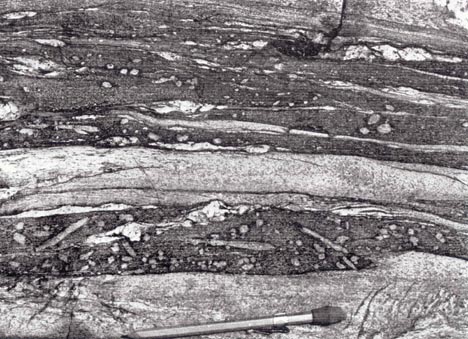 Image: Plate 20, Figure 2; Hopson (1964)
Image: Plate 20, Figure 2; Hopson (1964)
That’s pretty uncanny, eh? Two photos taken just over half a century apart, of the exact same square foot of clue-bearing rock.
So, we have here large, bladed crystals that formed as porphyroblasts of metamorphic minerals during prograde (↑P,↑T) metamorphism, then those same porphyroblasts found themselves unstable as temperatures and pressures dropped (retrograde metamorphism; ↓P,↓T). Their elemental constituents found themselves in disequilibrium, re-reacted, and formed new minerals which occupied the same space and shape as the large, bladed porphyroblasts. Today, you’ll finded that these “large, bladed crystals” are really aggregates of sericite (super-fine-grained muscovite).
So the question is, what were the metamorphic porphyroblasts that formed at peak P/T (and were subsequently replaced)? I mentioned kyanite as one possibility, right? However, Hopson noted these ‘ghostly’ shapes as “sillimanite (?).” Kyanite and sillimanite have a lot in common, but they aren’t the same thing. Like their polymorph andalusite, both kyanite and sillimanite have the chemical formula Al2SiO5. Both also grow in long bladed crystals. Check out these examples to prove this to yourself: kyanite | sillimanite
But in spite of these similarities, there’s a big difference between kyanite and sillimanite: they are stable at different combinations of temperature and pressure. Consider this classic P/T diagram:
If the sericitized pseudomorphs on the Billy Goat Trail were once sillimanite, then it implies higher temperatures. If they were once kyanite instead, then the temperatures were potentially lower. These rocks have plenty of un-retrograded sillimanite, but George Fisher (1971) was the one to invoke kyanite as the peak-P/T-porphyroblasts. He uses petrologic evidence to make the case that they were once close to ky/and/sil triple point. He says:
…the pelitic rocks contain many stubby crystals of andalusite, partially altered to sillimanite, and now largely pseudomorphed by fine aggregates of sericite. Andalusite partially altered to sillimanite is common at this end [south] of the island*, while at the north end of the island only bladed crystals of kyanite altered to sillimanite have been found. It appears as if the rocks at this end of the island must have entered the sillimanite field from the andalusite field, while the rocks farther north entered the sillimanite field from the kyanite field. If so, the rocks in the center of the island must have passed close to the triple point in the system Al2SiO5., about 5000 bars pressure [0.5 Gpa], and 650° C. The presence of muscovite and quartz in the sillimanite-bearing rocks reinforce this conclusion…
I assume he’s basing those statements on detailed petrologic evidence, but I haven’t seen his thin sections myself.
Tangentially, we’ve only been discussing the metasedimentary rocks so far, but E-an Zen and Phillip Candela point out in a 1998 guide to the area (for the University of Maryland geology department’s 25th anniversary hike) that the amphibolite units (meta-igneous, presumably) also contain kyanite or sillimanite but have not melted, which suggests temperatures in the range of 540° to 680° C, and pressures between 4.2 and 7 kbar (0.7 GPa).
So which is it? Kyanite or sillimanite? I can’t claim to know the answer: perhaps someone with more metamorphic petrology experience than me can shed some light on which mineral they they think they see in these ghostly pseudomorphs.
When I was out on the Billy Goat Trail last Friday with my GMU Structural Geology students, we ended up in that same general area. I challenged them to find the pseudomorphs, and it wasn’t five minutes before several of the students found excellent (though small) outcrops. Not the one that Cliff Hopson and I found, but other ones! Here are some shots to show their discoveries:
I have two questions for you: (1) What’s your favorite example of retrograde metamorphism? and (2) Have you had a similar photographing-the-same-spot-someone-else-did-many-years-before-you experience?
______________________________________________
Bierman, Paul, Zen, E-an, Pavich, Milan, and Reusser, Luke (2004). The Incision History of a Passive Margin River, the Potomac Near Great Falls, in USGS Circular 1264: Geology of the National Capital Region. Field trip guidebook.
Fisher, George W. (1971). The Piedmont crystalline rocks at Bear Island, Potomac River, Maryland. Maryland Geological Survey Guidebook No. 4, prepared for the 1971 annual meeting of the Geological Society of America, Field Trip No. 4.
Hopson, Clifford A. (1964). The Crystalline Rocks of Howard and Montgomery Counties. Maryland Geological Survey, Baltimore.
Zen, E-an, and Candela, Philip (1998). Department of Geology, University of Maryland: 25th anniversary geology hike to Great Falls, and the Chesapeake and Ohio Canal National Historical Park. Field trip guidebook: September 19, 1998.
* The “island” in question is Bear Island, which is not really an island (except during times of highest flooding). It’s just the land between the C&O Canal and the Potomac River in the vicinity of the Billy Goat Trail.

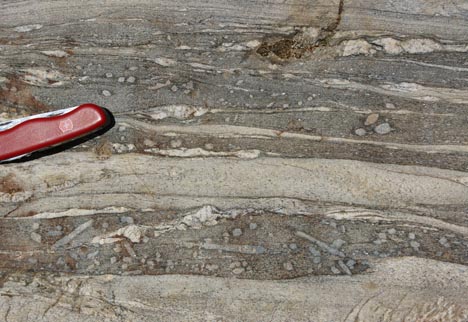

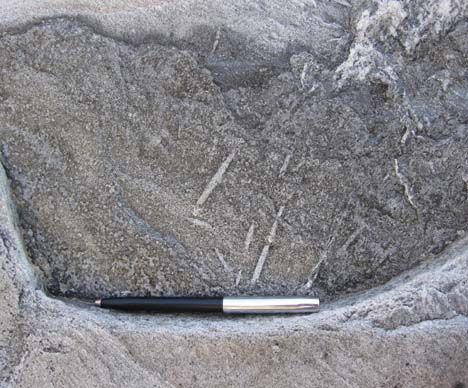
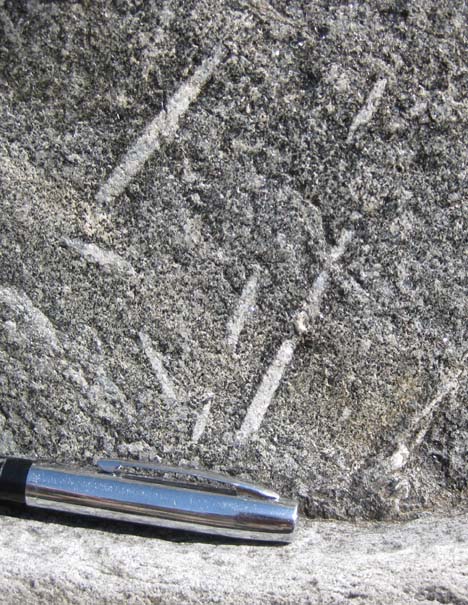
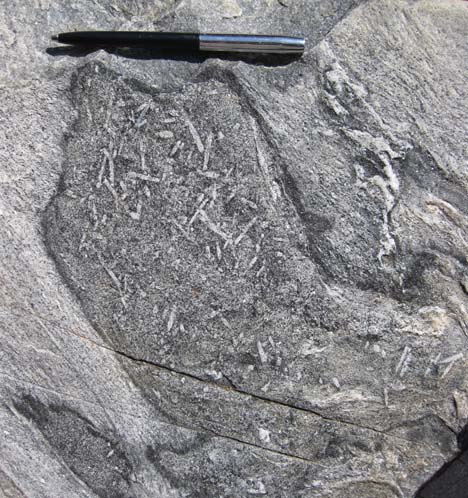
Ping!.
The outcrop photos look like either andalusite or coarse sillimanite to me. (I usually can’t work out the entire story until I see a thin section.)
I’ve got a rock that looks somewhat like the field photos at the bottom – except that the andalusite (confirmed from thin section) has been pulled apart.
I love it when I can see the metamorphic and the structural story in the same minerals.